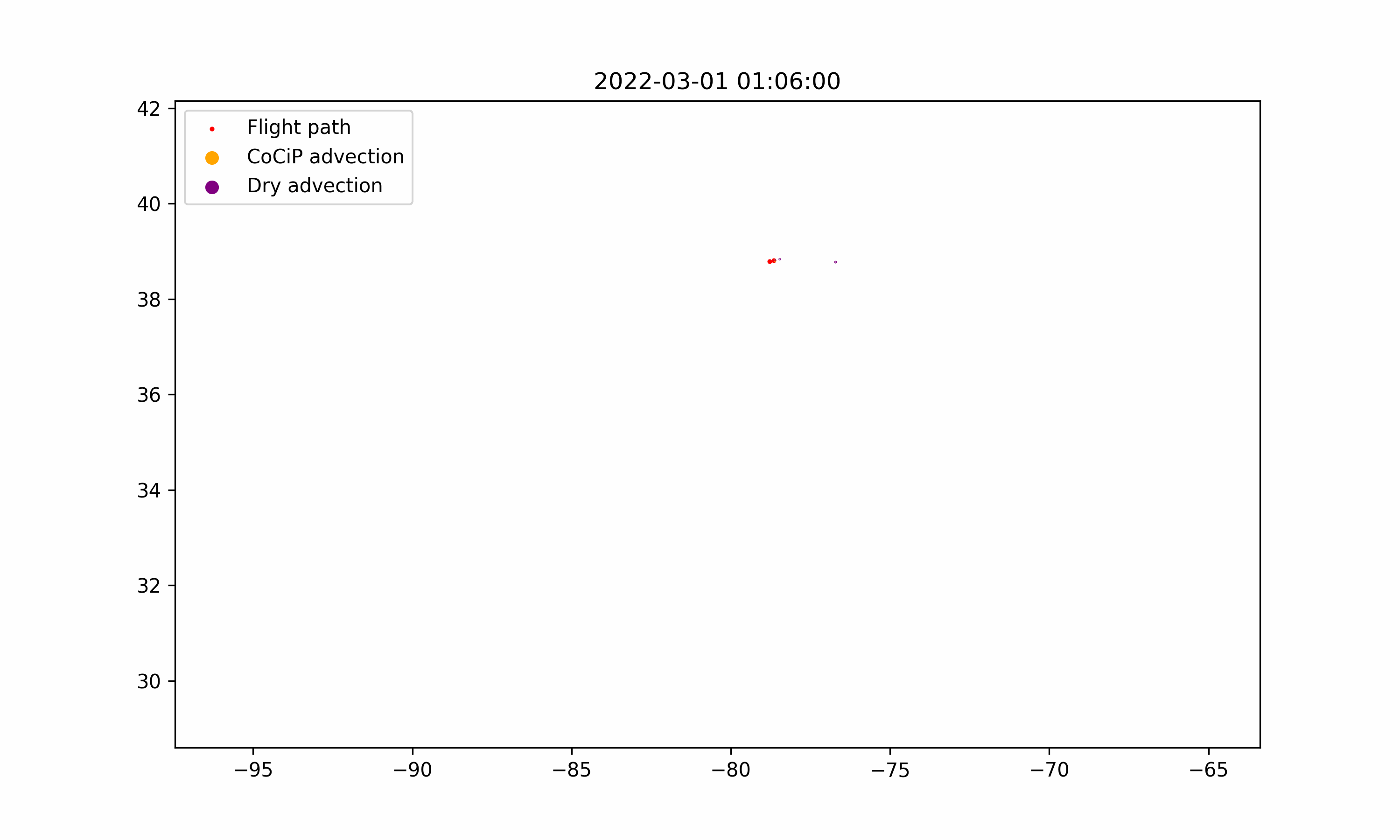Dry Advection¶
The Cocip model is designed to simulate the evolution and radiative forcing of a contrail over its lifetime. The model is intricate, relying on a number of meteorological variables and parameters governing the cloud microphysics.
If we are only interested in the evolution of the exhaust plume, we can use the DryAdvection model instead. This model is much simpler, and only requires the initial plume properties and a handful of meteorological variables (wind and temperature). This notebook demonstrates how to use the DryAdvection model and compares the results to the Cocip model.
[1]:
import pathlib
import matplotlib.pyplot as plt
import pandas as pd
from pycontrails import Flight
from pycontrails.datalib.ecmwf import ERA5
from pycontrails.models.cocip import Cocip
from pycontrails.models.dry_advection import DryAdvection
from pycontrails.models.humidity_scaling import ConstantHumidityScaling
from pycontrails.models.ps_model import PSFlight
from pycontrails.physics import units
plt.rcParams["figure.figsize"] = (10, 6)
Load data¶
Following patterns already used in the in the CoCiP notebook.
Meteorological data¶
[2]:
time_bounds = ("2022-03-01 00:00:00", "2022-03-01 12:00:00")
pressure_levels = (300, 250, 200)
era5pl = ERA5(
time=time_bounds,
variables=Cocip.met_variables + Cocip.optional_met_variables,
pressure_levels=pressure_levels,
)
era5sl = ERA5(time=time_bounds, variables=Cocip.rad_variables)
met = era5pl.open_metdataset()
rad = era5sl.open_metdataset()
Example flight¶
[3]:
df = pd.read_csv("data/flight.csv")
# Clip at 33,000 ft to hit more ISSR
df["altitude"] = df["altitude"].clip(upper=units.ft_to_m(33000))
# Create a flight instance
fl = Flight(df, aircraft_type="A320", flight_id="example")
Run DryAdvection and visualize plume evolution¶
[4]:
dt_integration = pd.Timedelta(minutes=2)
max_age = pd.Timedelta(hours=6)
params = {
"dt_integration": dt_integration,
"max_age": max_age,
"depth": 50.0, # initial plume depth, [m]
"width": 40.0, # initial plume width, [m]
}
dry_adv = DryAdvection(met, params)
dry_adv_df = dry_adv.eval(fl).dataframe
[5]:
ax = plt.axes()
ax.scatter(fl["longitude"], fl["latitude"], s=3, color="red", label="Flight path")
ax.scatter(
dry_adv_df["longitude"], dry_adv_df["latitude"], s=0.1, color="purple", label="Plume evolution"
)
ax.legend()
ax.set_title("Flight path and plume evolution under dry advection");
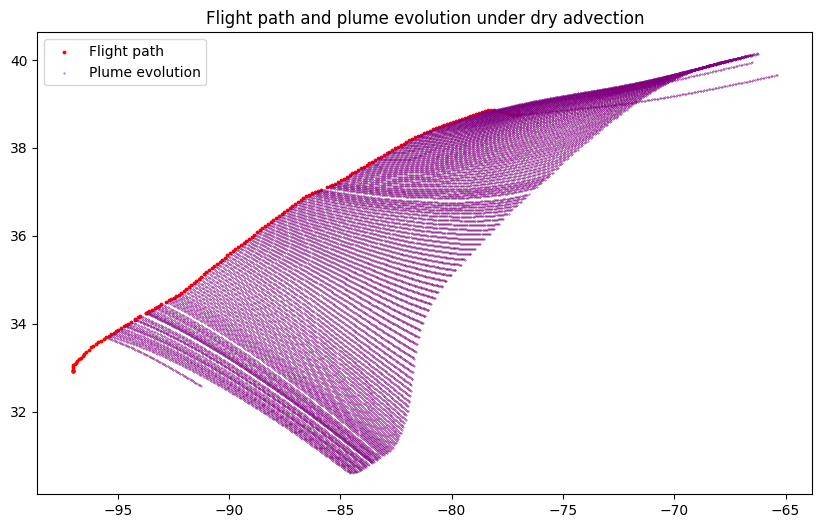
Run Cocip and visualize evolution¶
[6]:
params = {
"dt_integration": dt_integration,
"max_age": max_age,
"humidity_scaling": ConstantHumidityScaling(rhi_adj=0.9),
"aircraft_performance": PSFlight(),
}
cocip = Cocip(met, rad, params)
cocip.eval(fl)
cocip_df = cocip.contrail
[7]:
ax = plt.axes()
ax.scatter(fl["longitude"], fl["latitude"], s=3, color="red", label="Flight path")
ax.scatter(
cocip_df["longitude"], cocip_df["latitude"], s=0.1, color="orange", label="Plume evolution"
)
ax.legend()
ax.set_title("Flight path and plume evolution under CoCiP");
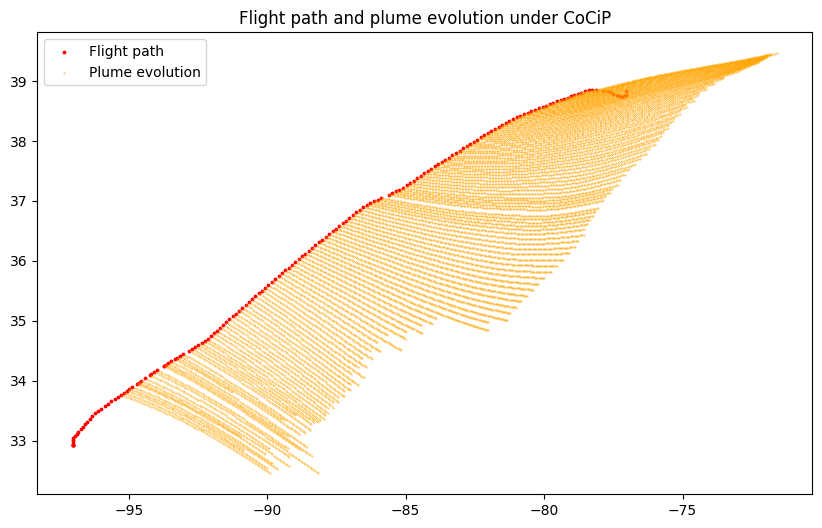
Comparison with CoCiP¶
Dry Advection |
CoCiP |
|
|---|---|---|
Horizontal advection |
Yes |
Yes |
Vertical advection |
Yes |
Yes |
Assumes elliptical plume |
Yes |
Yes |
Evolves plume geometry (width, depth) |
Yes |
Yes |
Possible to run in pointwise mode (no width nor depth) |
Yes |
No |
Considers ice growth and sedimentation |
No |
Yes |
Calculates radiative forcing |
No |
Yes |
Models cloud microphysics |
No |
Yes |
Calculates end of life condition at each time step |
No |
Yes |
Requires aircraft performance model |
No |
Yes |
Allows arbitrary initial ellipse dimensions (width, depth) |
Yes |
No |
Visualize advected altitude¶
While the horizontal position of the advected waypoints are relatively similar in both simulations, the altitude of the evolved plume can substantially differ. In CoCiP, the initial contrail is calculated based on an assumed downwash simulation. This typically lowers the contrail depth several hundred meters below the altitude of the flight path. In addition, because CoCiP simulates ice crystal growth and sedimentation, the contrail altitude typically decreases as ice crystals grow and sediment. The dry advection model does not consider sedimentation, and the plume altitude is initially assumed to be the same as the flight altitude. The following figure shows the altitude of the advected waypoints in both simulations.
[8]:
# Consider a sample waypoint
waypoint = 30
tmp1 = dry_adv_df.query(f"waypoint == {waypoint}")
tmp2 = cocip_df.query(f"waypoint == {waypoint}")
ax = plt.axes()
ax.plot(tmp1["time"], units.pl_to_ft(tmp1["level"]), label="Dry advection")
ax.plot(tmp2["time"], units.pl_to_ft(tmp2["level"]), label="CoCiP advection")
ax.set_xlabel("Time of evolution (s)")
ax.set_ylabel("Altitude (ft)")
ax.set_title(f"Altitude of plume evolution at waypoint {waypoint}")
ax.legend();
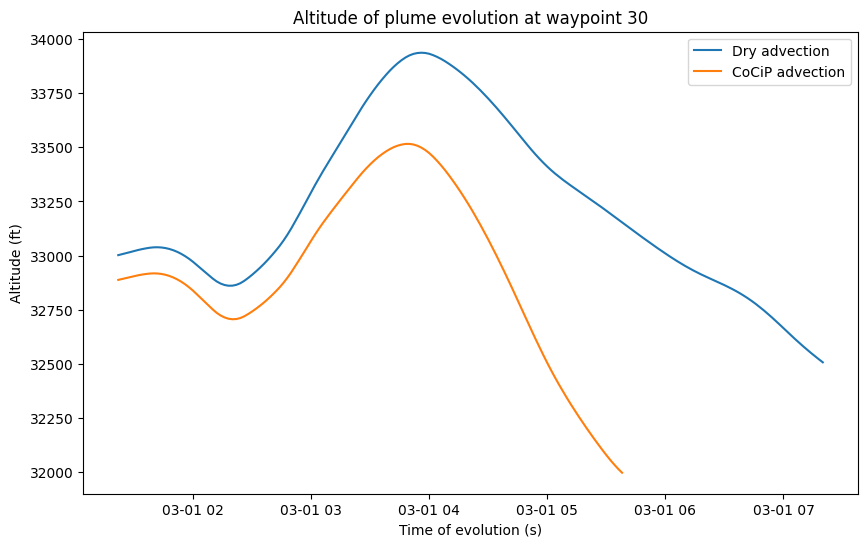
Visualize advected width¶
Both CoCiP and dry advection assume the geometry of the plume has an elliptical cross section. The width and depth of this plume evolve according to wind shear effects. Presently, the wind shear enhancement in Cocip is not implemented in DryAdvection. This explains why the Cocip-derived plume is typically wider than the DryAdvection-derived plume.
[9]:
ax = plt.axes()
ax.plot(tmp1["time"], tmp1["width"], label="Dry advection")
ax.plot(tmp2["time"], tmp2["width"], label="CoCiP advection")
ax.set_xlabel("Time of evolution (s)")
ax.set_ylabel("Width (m)")
ax.set_title(f"Width of plume evolution at waypoint {waypoint}")
ax.legend();
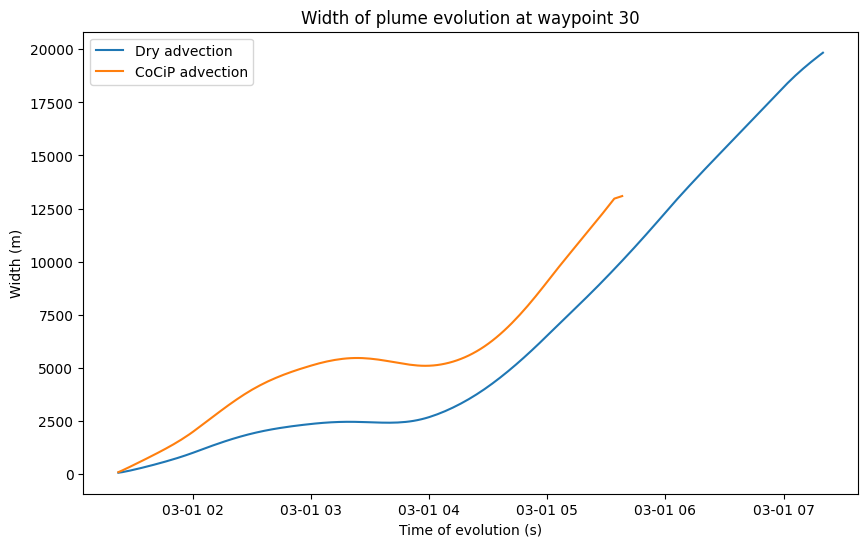
Animate the two evolutions¶
[10]:
from IPython.display import Image
from matplotlib.animation import FuncAnimation, PillowWriter
[11]:
fig, ax = plt.subplots()
ax.set_xlim(dry_adv_df["longitude"].min() - 2, dry_adv_df["longitude"].max() + 2)
ax.set_ylim(dry_adv_df["latitude"].min() - 2, dry_adv_df["latitude"].max() + 2)
scat1 = ax.scatter([], [], s=2, color="red", label="Flight path")
scat2 = ax.scatter([], [], color="orange", label="CoCiP advection")
scat3 = ax.scatter([], [], color="purple", label="Dry advection")
ax.legend(loc="upper left")
source_frames = fl.dataframe.groupby(fl.dataframe["time"].dt.ceil(dt_integration))
dry_adv_frames = dry_adv_df.groupby(dry_adv_df["time"].dt.ceil(dt_integration))
cocip_frames = cocip_df.groupby(cocip_df["time"].dt.ceil(dt_integration))
times = cocip_frames.indices
def animate(time):
ax.set_title(time)
try:
group = source_frames.get_group(time)
except KeyError:
offsets = [[None, None]]
else:
offsets = group[["longitude", "latitude"]]
scat1.set_offsets(offsets)
group = cocip_frames.get_group(time)
offsets = group[["longitude", "latitude"]]
width = 1e-3 * group["width"]
scat2.set_offsets(offsets)
scat2.set_sizes(width)
group = dry_adv_frames.get_group(time)
offsets = group[["longitude", "latitude"]]
width = 1e-3 * group["width"]
scat3.set_offsets(offsets)
scat3.set_sizes(width)
return scat1, scat2
plt.close()
ani = FuncAnimation(fig, animate, frames=times)
filename = pathlib.Path("evo.gif")
ani.save(filename, dpi=300, writer=PillowWriter(fps=10))
# Show the gif
display(Image(data=filename.read_bytes(), format="png"))
# Cleanup
filename.unlink()
